Project Introduction
AltLayer is a decentralized and scalable Rollup-as-a-Service (RaaS) protocol that allows application developers to quickly launch highly scalable custom execution layers (also known as Layer 2). It can save developers a lot of funds and development time while encouraging innovation and rapid experimentation. AltLayer also supports multiple chains and multiple VMs, with default support for EVM and WASM. Therefore, AltLayer is not confined to a single Layer 1 or Layer 2 but can be used as a modular and pluggable extension solution for all EVM and WASM compatible chains. The project aims to become a key infrastructure in the Ethereum ecosystem to solve scalability issues.
Author
JUMPENG, senior researcher at WJB. He holds a master’s degree in finance from Huazhong University of Science and Technology and has 7 years of industry experience. He is proficient in areas such as Layer 1, DeFi, NFT, Layer 2, and Gamefi. He has researched over 2000 projects and produced more than 500 in-depth research reports.
1. Research Points
1.1. Core Investment Logic
AltLayer is expected to become the AWS of the blockchain industry, providing flexible, low-cost, and fast deployment RaaS solutions for various application scenarios. Here are some of its core investment logics:
Excellent technical development team: This is a key factor in its investment value. AltLayer’s team members have a strong background, most of whom come from top projects in the blockchain field. Founder Yaoqi Jia was a co-founder and CTO of Zilliqa and is an expert in blockchain security. Growth Lead Dorothy Liu has experience as the Head of Synthetix China. With a team composed of blockchain technology experts, they have deep industry experience and technical vision. They are able to design products that meet market demands and carry out solid technical implementations, which is an important guarantee for AltLayer to stand out in a competitive market.
- Ethereum Validators Surge! What problem does the new proposal EIP-7514 by Dencun aim to solve?
- IOBC takes stock of Singapore’s popular projects in 2049 a new narrative for a new era
- MetaMask Snap The Revolution of Wallets, the New Playground for Developers
AltLayer has two major technological innovations in product design: no-code deployment and decentralized coordination. AltLayer provides a no-code graphical interface, allowing developers to launch an application-specific rollup in minutes without writing any code. Compared to developing a rollup from scratch using programming languages, AltLayer significantly reduces the development threshold, enabling more people to enjoy the benefits of rollup. In addition, AltLayer has built a decentralized Beacon Layer, which can allocate nodes to provide order and verification services for the rollup, and incentivize them with tokens. This further reduces the difficulty of using rollup and improves overall security. This no-code and decentralized design brings great convenience to AltLayer’s RaaS service model. The convenience and usability also make this model highly replicable and applicable to more application scenarios. These technological advantages not only create value for users but also drive AltLayer to gain a higher market share and more users.
Clear market positioning and demand: AltLayer is based on the scalability needs of the Ethereum ecosystem, and its product design and technological innovation are aimed at the determined direction of rollup technology. It has a high degree of fit with the Ethereum ecosystem and meets significant and continuous market demand. Compared with other competitors, AltLayer has a greater first-mover advantage in the field of rollup, which becomes a very core investment logic for AltLayer – it grasps the trend of blockchain development, stands at a positive opportunity point, and has a very high-quality market positioning. This will be an important foundation for driving rapid growth for AltLayer.
Advanced technology framework design and high usability of services and products: AltLayer has made a lot of usability optimizations in product design, providing a very concise and intuitive user experience and interface. These include: – Codeless Rollup launcher, deployed through a graphical interface; – Clear and concise operation process, easily completing the creation and management; – Comprehensive documentation and community support, reducing learning barriers; – Integrated ChatGPT for intelligent user guidance; – Support for common wallet access, maintaining user habits, etc. These usability designs greatly enhance the usability of AltLayer products, making it easy for different user groups, including non-technical personnel, to get started. In addition to directly improving user experience, this will also help AltLayer achieve higher user activity and market penetration. In addition, AltLayer has also made a lot of technological innovations in architectural design, achieving a modular and layered technical framework. This configurable design supports high customization, allowing AltLayer to flexibly optimize for different application scenarios. This advanced technical architecture will also ensure the scalability, interoperability, and future sustainable development of AltLayer. These innovative designs not only directly improve the quality of products and services but also promote AltLayer to achieve excellent commercial performance and maintain a leading technological position.
1.2. Valuation
Currently, AltLayer has not disclosed its token model and valuation, so it is not possible to accurately evaluate it.
1.3. Project Risks
The risks of AltLayer mainly come from technical risks, business risks, system risks, and other comprehensive risks. For details, please refer to the content of the project disadvantages and threats in this report 5.2.
2. Project Overview
2.1. Project Introduction
AltLayer is a decentralized Elastic Rollup as a Service (RaaS) protocol, dedicated to providing developers with highly customizable and scalable blockchain execution environments. AltLayer allows developers to easily and quickly deploy their own Rollup based on mainstream public chains such as Ethereum, while ensuring security and decentralization. This application-specific Rollup execution layer can be customized in terms of functionality and parameters according to the actual needs of the project, such as transaction fees, consensus mechanisms, virtual machines, etc. Compared with deploying directly on the public chain or Layer 2 networks, AltLayer provides greater flexibility and control for projects. Compared with building a separate chain, AltLayer reduces maintenance costs and improves resource utilization efficiency. At the same time, AltLayer has elastic scaling capabilities, which can dynamically allocate resources and validation nodes based on the actual usage of the execution layer. It also provides cross-chain interoperability, allowing assets on the execution layer to seamlessly flow between different chains.
In general, AltLayer combines the security of public chains with the customization of application chains, making it a new Rollup-as-a-Service solution. It has the advantages of usability, efficiency, interoperability, etc., and is expected to become an important infrastructure in the Web3 world, providing strong support for decentralized applications.
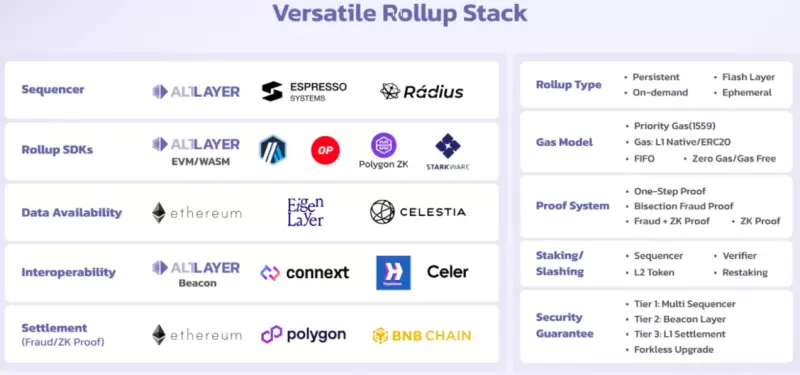
2.2. Team Information
2.2.1. Overview
AltLayer was founded by a group of senior experts in the blockchain field, with founder Yaoqi Jia previously being the co-founder and CTO of Zilliqa, possessing extensive experience in technical research and development. In addition to the founder, AltLayer’s core team members include industry veterans such as Dorothy Liu, who was previously in charge of Synthetix in China. The core team members have strong capabilities and provide unique perspectives on blockchain technology and applications.
2.2.2. Core Members

Yaoqi Jia: Former co-founder and CTO of Zilliqa, he is also one of Forbes Asia’s 30 Under 30 elites. He obtained a Ph.D. in Computer Science from the National University of Singapore and has published several top-tier journal articles in the fields of network security, privacy, and distributed system security. His work has been recognized by multiple vendors such as Google and Apple, and has attracted media attention. He is currently leading advanced systems seminars at the National University of Singapore and participating in a research group on network security.

Tan Jun Hao: Co-founder and CEO of AltLayer, he is an experienced blockchain developer and entrepreneur. He was a core developer of Synthetix, responsible for the development and maintenance of smart contracts and front-end of the project. He also worked as a senior software engineer at Kyber Network, participating in the development and optimization of decentralized exchanges.
2.3. Financing Situation
On July 1, 2022, AltLayer completed a $7.2 million seed round of financing, led by Polychain Capital, Jump Crypto, and Breyer Capital. Participating investors include Gavin Wood, the founder of Polkadot, Balaji Srinivasan, former CTO of Coinbase, Sean Neville, co-founder of Circle, Kain Warwick and Jordan Momtazi, co-founders of Synthetix. The financing will be used to expand the existing team of about 10 people to about 25 people and launch its platform later this year.
On August 4, 2022, Binance Labs announced that it has invested in four outstanding projects in MVB VI, including AltLayer, perpetual contract DEX KiloEx, DeFi lending protocol Kinza, and AI game Sleepless AI. However, no specific details were disclosed.

2.4. Development History and Roadmap
2.4.1. Development History
Date Event
2022-7-1 AltLayer completed a $7.2 million seed round of financing, led by Polychain Capital and others.
2022-8-24 AltLayer will host the Dark Forest on its game-specific execution layer and hold a Dark Forest community round.
2022-10-01 AltLayer launched the Alpha Developer Network, allowing developers to deploy Solidity contracts and test cross-chain solutions.
2023-04-27 AltLayer’s RaaS (Rollups-as-a-Service) solution supports the L3 blockchain Arbitrum Orbit.
2023-05-05 AltLayer announced the launch of the Multi-Sorter Testnet Rollup, promising to alleviate the review system and enhance the security and availability of the Rollup.
2023-07-21 AltLayer announced the use of Celestia’s Data Availability (DA) layer to address data availability issues and verify the Rollup state in a trustless manner.
2023-07-27 AltLayer announced the deployment of over 100,000 Flash Layers as part of the Altitude Phase 3.
2023-08-04 Binance Labs announced investments in four outstanding MVB VI projects, including AltLayer.
2023-08-17 AltLayer partnered with ARLianGuai Network to integrate its on-chain verifiable random number generator, Randcast.
2023-08-24 AltLayer will integrate the Sovereign SDK to optimize its Rollup.
2023-08-28 AltLayer announced that its rollups suite added support for OP Stack, allowing DApps to quickly launch on AltLayer’s no-code Rollup platform.
2023-08-30 Automata and AltLayer will collaborate to develop the modular proof L2 Automata 2.0.
2.4.2. Current Progress
AltLayer has announced project progress in the following areas:
• In terms of transaction sorters, AltLayer has implemented decentralized consensus, anti-MEV, and shared sorter clusters. However, the penalty mechanism and cross-rollup messaging functionality are still under development.
• In terms of runtime environment, AltLayer has supported EVM and WASM, but Solana and Move environments are still under development.
• In terms of verification, AltLayer has implemented the two-phase fraud proof, but fraud proof in the mainnet environment is still under development.
• In terms of multi-chain support, AltLayer has supported Ethereum and other chains, but Solana support is still under development.
• In terms of the frontend, AltLayer has developed interfaces for deployment, asset settlement, ChatGPT integration, etc.
• The Rollup SDK is also still under development.
In addition, AltLayer provides documents such as performance test reports, case studies, testnet overview, FAQs, tool resources, and community support.
Overall, AltLayer has made smooth progress in transaction sorting, runtime environment, and multi-chain support, while advanced features such as penalty mechanisms, cross-chain messaging, and mainnet fraud proofs are still being developed. Frontend development and document support are also steadily being rolled out as AltLayer advances towards its goal of building a professional RaaS platform.
2.4.3. Development Plan and Roadmap
In addition to completing the ongoing development of technical features, AltLayer has the following plans for future development:
• Plan to launch its testnet in the second half of 2023, allowing developers and users to experience the functionality and advantages of its RaaS (Rollup as a Service) protocol.
• Plan to launch its mainnet in the first half of 2024, officially starting its RaaS protocol service, allowing developers and users to deploy and use its execution layer and applications.
• Plan to launch its cross-chain bridge service in the second half of 2024, enabling the transfer and communication of execution layers and applications between different underlying chains.
• Plan to launch its governance DAO in the first half of 2025, allowing community members to participate in the governance and decision-making of the protocol through native tokens.
• Plan to launch its ecosystem incentive program in the second half of 2025, allowing developers and users to earn protocol rewards and incentives through native tokens.
2.5. Social Media Data
As of September 2, 2023, AltLayer has performed well on social media platforms, indicating high project popularity. The main channels currently operated by the project include Twitter, Discord, Telegram, and Medium. Currently, AltLayer’s Discord account has attracted nearly 550,000 followers, with a daily online population of nearly 10,000, making it one of the most popular channels. Additionally, there is frequent interaction on Twitter. The specific data for each platform is as follows:
Media Channels: Twitter Discord Telegram Medium
Number of Followers: 448,701 552,010 3,675 7,600
Online/Active: Frequent Updates 9,907 895 Updates 7 articles
3. Project Analysis
3.1. Project Background
To solve the scalability issues facing blockchain, various scaling solutions have been proposed by the community, including sidechains, state channels, Plasma, etc. Among them, Rollup technology, which improves throughput by batch processing transactions and offloading computations off-chain, is considered one of the most promising pathways. Rollups can be divided into two main categories: Optimistic Rollup, which ensures security through fraud proofs, and ZK Rollup, which uses zero-knowledge proofs to verify transaction validity. Although Rollups improve scalability, they still face challenges such as high development complexity, limited environment, resource waste, and lack of composability.
To address these pain points, AltLayer has emerged as a Rollup as a Service (RaaS) protocol. It provides a decentralized framework that allows developers to easily launch and manage their own Rollup execution layers. Compared to deploying directly on the chain, AltLayer offers developers greater flexibility and control, mitigating the risk of significant transaction fee fluctuations, and achieving low latency and high throughput. It also helps internalize transaction fees for developers, providing more practical use cases for tokens. AltLayer makes developing Rollups easier and incorporates its economic design into the protocol, aiming to become a resilient and efficient Rollup infrastructure that provides strong support for decentralized applications.
3.2. Project Principle
AltLayer uses Optimistic Rollup technology to build a fast and scalable application layer that can be easily deployed on public chains for security. It supports EVM and WASM and can serve as a flexible scaling solution, providing scalability support for different public chains and applications.
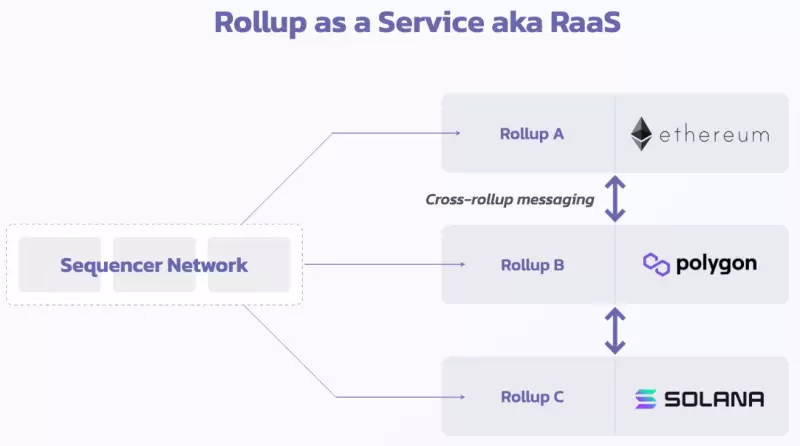
Since AltLayer is mainly based on Optimistic Rollup technology, it is also compatible with ZK-Rollup technology. For easy understanding, let’s first explain the working principle of Optimistic Rollup:
① Run an execution environment (such as EVM or WASM) on Layer2, allowing users to deploy and execute contracts on Layer2, and send and receive transactions.
② Run a sequencer node (also known as a sorter) on Layer2, responsible for collecting user transactions, packaging them into blocks in a certain order, and submitting the block hash and state root to the smart contract (also known as a validator contract) on Layer1.
③ Run a validator contract on Layer1, responsible for receiving and storing the block hash and state root submitted on Layer2, and providing a fraud proof mechanism that allows anyone to challenge and verify the blocks on Layer2.
④ Establish a bridging protocol between Layer1 and Layer2, allowing users to transfer and exchange assets and data between the two layers. The bridging protocol usually requires a certain delay time (also known as a challenge period) to ensure that the blocks on Layer2 are not challenged or proven invalid.
In summary, the operation of Optimistic Rollup is: process transactions in batches on the L2 chain, without the need to put each transaction on the chain, and then periodically submit these batch transaction data to the Ethereum mainnet. The Ethereum mainnet only checks the validity of the submitted data and does not need to execute each transaction. This design greatly improves transaction throughput and reduces gas costs.
AltLayer has made some innovations and optimizations based on Optimistic Rollup, mainly including the following aspects:
• Built an independent sequencer network Beacon Chain, responsible for sorting Rollup transactions;
• The core components are developed from scratch using the Substrate framework, supporting EVM and WASM execution;
• Supports interaction with multiple public chains as a general scaling solution;
• Introduces the concept of disposable execution layer: AltLayer allows developers to start and dispose of the execution layer according to demand, achieving resource optimization and composability. AltLayer introduces the concept of a disposable execution layer, allowing developers to start the execution layer within a short period of high anticipated demand and complete transactions on the execution layer. Once the demand decreases, the assets will settle on Layer1 and the execution layer will dissolve. This model is suitable for short-term use cases such as NFT minting and game activities.
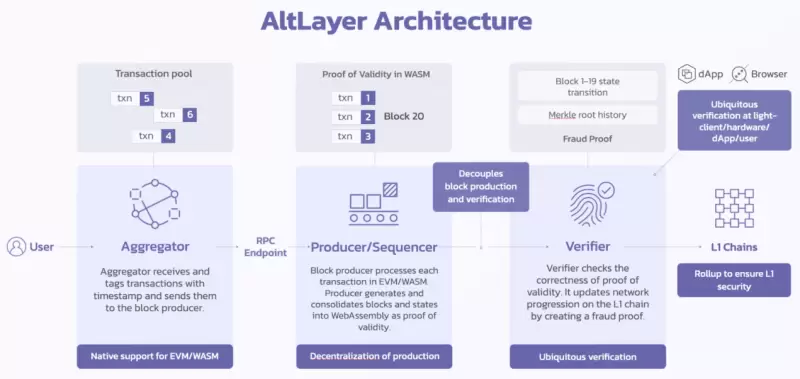
Specifically, AltLayer divides the transaction lifecycle into three stages: aggregation, block generation, and verification:
① First, the aggregator collects transactions from different channels, timestamps and sorts them, and then submits the batch of transactions to the block producers according to load balancing requirements.
② The block producer is responsible for selecting the transaction sequence, executing these transactions locally, and packaging them into new blocks. AltLayer defaults to a single producer mode to achieve low latency, but multiple producers can also be configured to increase decentralization. The block producers reach consensus through the GRANDLianGuai consensus protocol.
③ The validators first validate the newly generated blocks for validity, and then periodically generate packets of block data and submit them to the main chain. Before submission, the validators need to generate transaction and instruction-level state roots for on-chain verification. The validators are also responsible for fraud proofs and dispute resolution.
④ AltLayer provides layered transaction finality guarantees, including execution level, validation level, and aggregation level. Users can choose the level of finality required based on their security needs. After the challenge period ends without disputes, the blocks are confirmed as final.
⑤ AltLayer also has a Beacon layer, which serves as a shared distributed sorting node cluster. When users request to start a Rollup, the Beacon layer selects sorting nodes to provide services based on the nodes’ staking weights.
⑥ Considering the OP-Rollp execution model, AltLayer uses binary search to prevent fraud. When disputes occur, the range can be gradually narrowed down to locate the specific disputed instructions, efficiently resolving disputes.
In simple terms, AltLayer supports multiple chains and processes transactions in three steps: aggregation, block generation, and verification. It has a single producer or multiple producers to achieve consensus in block production. In addition to validating blocks, validators also submit data to the main chain. AltLayer has three levels of finality, and users can choose the desired security level. It also has a shared sorting node cluster, the Beacon layer, which assigns sorting nodes based on user requests. Considering the possibility of disputes in OP-Rollp execution, AltLayer uses binary search to gradually narrow down the range, efficiently resolving disputes.
In summary, AltLayer combines the high performance and scalability of Optimistic Rollup with its own customization and portability. It provides a flexible scaling framework for different chains, allowing resources to be dynamically adjusted according to needs while ensuring security. This technical design makes it a valuable and feasible Rollup-as-a-Service solution.
3.3. Project Technical Features
AltLayer’s project technical features mainly include the following:
• Modularity: AltLayer’s modular design allows customization for different applications. It separates different functions and components, allowing developers to choose and combine according to their needs and preferences. AltLayer provides various customization options and templates, allowing developers to choose different expansion types, virtual machine types, data availability modes, and sorter modes.
• Elasticity: Elastic scalability and efficient resource utilization. AltLayer can dynamically adjust and optimize its parameters and mechanisms based on different networks and market conditions. AltLayer can adjust its expansion type, data availability mode, sorter mode, etc., based on the data availability of Layer 1 and the transaction demands of Layer 2. It can also adjust its service fees, staking rates, and reward allocations based on user feedback and community voting. For example, developers can choose to activate Flash Layer during high traffic to increase throughput and disable it during low traffic to save costs.
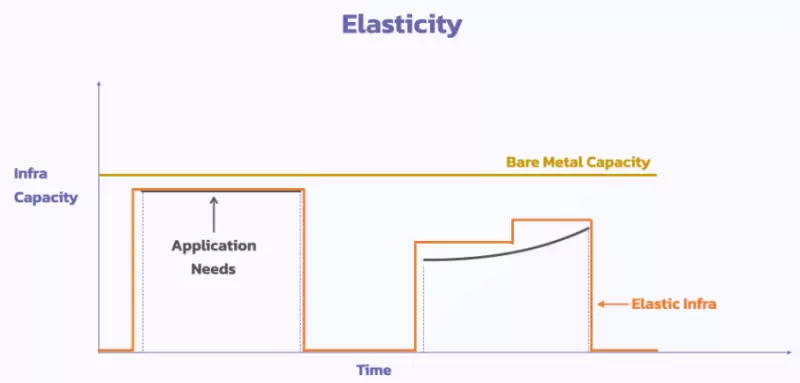
• Multiple virtual machine support: providing developers with more choices. AltLayer can support different types of virtual machines, such as EVM and WASM, etc. This allows AltLayer to be compatible with different smart contract languages and applications, such as Solidity, Rust, C++, etc. It also allows developers to use different types of virtual machines on the same Rollup, achieving greater flexibility and efficiency.
• Fraud proof: built-in fraud proof mechanism to ensure security. AltLayer can use cryptographic methods to ensure the correctness of Layer 2 transactions without relying on challenge periods or zero-knowledge proofs. AltLayer uses a fraud proof scheme based on RSA signatures, which requires the sequencer node to provide a signature when submitting data to prove the correctness of the data. If someone discovers that the sequencer node has submitted incorrect data, they can provide a fraud proof, which is a counterexample transaction, to prove that the sequencer node’s signature is forged. This way, AltLayer can improve efficiency and reduce costs without sacrificing security.
• Decentralized sequencer: improving reliability. AltLayer achieves decentralized sequencing through the Beacon Layer, which allows anyone to join the network as a sequencer and has the opportunity to be selected to serve the dedicated launcher. This increases the security and decentralization of the network and provides incentives for sequencers.
• Layered finality: balancing security and performance. AltLayer adopts a mechanism of layered finality, where transactions on Layer 2 can achieve finality in a short period of time, while transactions on Layer 1 require a longer wait. This improves user experience and efficiency while ensuring the security of Layer 1. This way, AltLayer can balance the trade-off between efficiency and security.
• Codeless dashboard: simplifying Rollup deployment and usage. AltLayer provides a codeless dashboard (Rollup LaunchLianGuaid) that allows non-professional developers to easily create and launch their own Rollups. The codeless dashboard provides various customization options and templates, allowing users to choose different expansion types, virtual machine types, data availability modes, sequencer modes, etc. through simple clicks and drags. The codeless dashboard also provides some common application scenarios and examples, such as games, NFTs, social networks, etc., allowing users to quickly deploy and run their own applications.
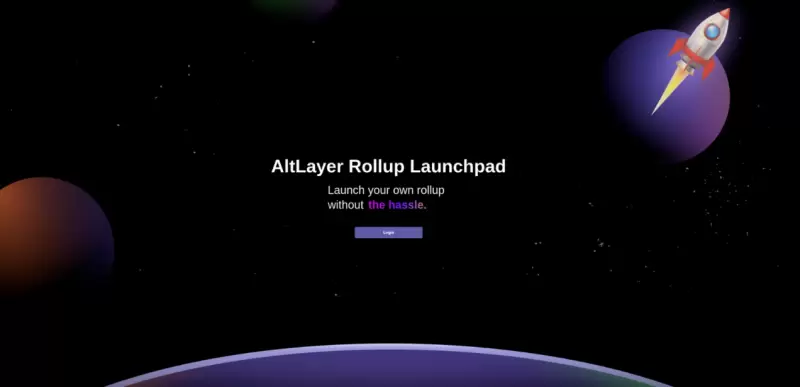
3.4 Beacon Layer
The Beacon Layer is one of the core components of AltLayer, providing coordination and validation between the execution layer and the data availability layer. The Beacon Layer provides the following main services:
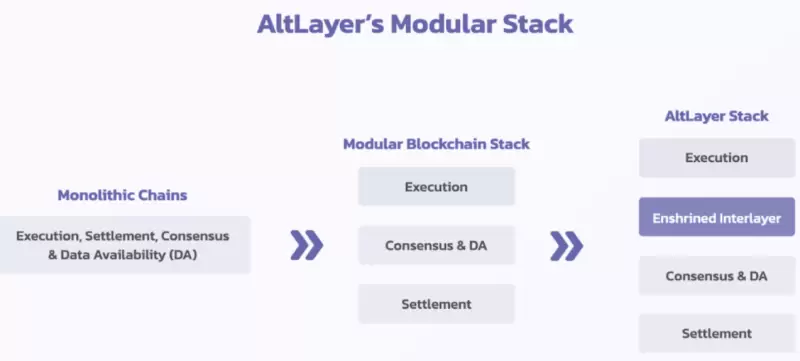
• Shared Sequencing Layer: The shared sequencing nodes in the Beacon Layer provide transaction sequencing services for Rollups in AltLayer. It is the bottommost layer of the Beacon Layer, a decentralized network that anyone can join, where each node can act as a sequencer to collect and execute transactions on Layer 2, and submit block headers and Merkle roots to the smart contracts on Layer 1. The shared sequencing layer uses a staking/slash mechanism to incentivize and penalize the behavior of sequencers, ensuring the security and liveliness of the network.
• Verification Layer: Verification nodes are responsible for verifying transactions in Rollup to ensure the security of the execution layer. The Beacon Layer provides a verification layer for AltLayer, allowing non-professional developers to create and launch their own Rollups through a codeless dashboard and have dedicated sequencer nodes allocated to serve them. The verification layer uses a verification scheme based on data availability sampling (DAS), which allows Layer 2 validators to verify the correctness of Layer 2 transactions by randomly sampling a portion of data from the Beacon Layer network, without the need to download or store all Layer 1 data. The verification layer also provides validators with a mechanism for fraud proof, allowing validators to submit a fraud proof to the Beacon Layer and punish sequencer nodes and restore the correct state of Layer 2 when they discover that a sequencer node has submitted incorrect data.
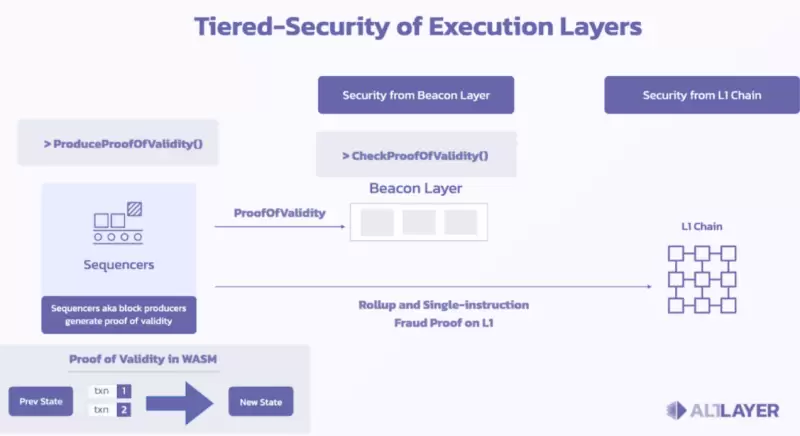
• Staking/Slashing Layer: The Beacon Layer provides a staking/slash layer for AltLayer, allowing users to participate in staking and slashing of the AltLayer protocol by holding AltLayer’s native tokens. The staking/slash layer uses a Proof of Stake (PoS) based staking/slash scheme, which allows users to stake native tokens into the Beacon Layer network to obtain corresponding rewards or losses. The staking/slash layer also provides users with a dynamic adjustment mechanism, allowing users to adjust their staking rate and yield based on network and market changes.
• Interoperability Layer: Enables assets on Rollup to be easily transferred across different chains. The Beacon Layer provides an interoperability layer for AltLayer, allowing users to perform cross-layer transactions and data transfers between different Rollups or other Layer 2 solutions. The interoperability layer uses an interoperability scheme based on Hyperlane, which allows users to leverage Hyperlane’s cross-chain protocol to achieve permissionless interoperability. The interoperability layer also provides users with a cross-chain bridging mechanism, allowing users to perform cross-chain transactions without having to hold or pay any tokens using Biconomy’s meta-transaction service.
• Upgradeability Layer: Allows for smooth upgrades of the components of the Beacon Layer. This is the fifth layer of the Beacon Layer, which is a centralized layer composed of smart contracts on Layer 1, where each smart contract can be upgraded based on social consensus to upgrade the various sub-layers of the Beacon Layer. The upgradeability layer uses governance tokens to achieve social consensus, ensuring the flexibility and adaptability of the network. At the same time, it provides developers with a compatibility guarantee mechanism, allowing developers to upgrade and optimize without affecting users and applications.
• Social Consensus Layer: Implements on-chain governance based on ALT holders’ voting, etc. This is the top layer of the Beacon Layer, which is a decentralized community composed of AltLayer Token holders, where each holder can participate in the governance and upgrade of the Beacon Layer. The social consensus layer uses a voting mechanism to achieve social consensus, ensuring the democracy and fairness of the network.
3.5. Rollup Types on AltLayer
AltLayer provides two types of Rollups, namely Flash Layer and Persistent Rollups.
3.5.1. Flash Layer Rollups
Flash Layer is a temporary and one-time rollup provided by AltLayer, with optional fraud proof. It can be quickly created when there is a short-term increase in dApp demand, such as during airdrop activities. Flash Layer can rapidly scale up to prevent congestion on the underlying chain. When the activity ends, it can transfer the state and assets back to the underlying chain and then be deleted to release resources. Flash Layer provides an instant scaling solution that can be used and discarded, avoiding the waste of resources in permanently maintaining a chain or contract. It leverages the advantages of rollup to provide elastic scaling and has the following characteristics:
• No deposit/withdrawal required: Users can use the services of Flash Layer without depositing or withdrawing funds on Layer1. They only need to use their wallet and wallet address and signature on Layer1 to transact on Flash Layer.
• No challenge period required: Flash Layer does not need to set a challenge period to prevent fraud, because it uses a trust-based mechanism, which means that users can only transact with sorters they trust. If a sorter cheats, users can arbitrate on Layer1 and receive compensation.
• No data publication required: Flash Layer does not need to publish data to Layer1 to ensure security. It uses a signature-based mechanism, which means that users can only transact on Flash Layer using their wallet address and signature on Layer1. If a sorter loses data, users can provide evidence on Layer1 and receive compensation.
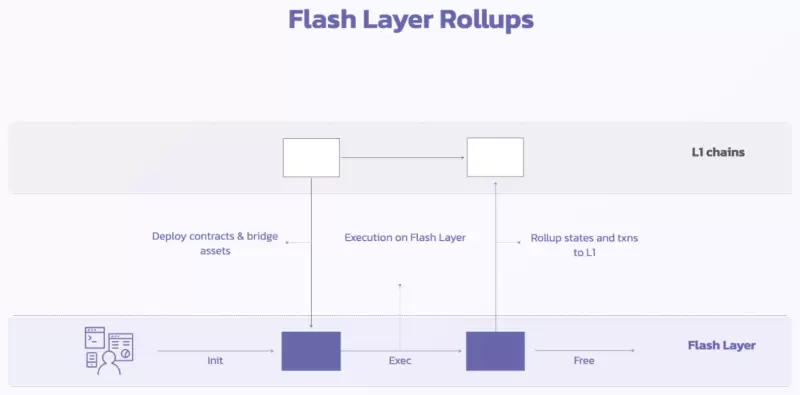
3.5.2. Use Cases of Flash Layer Rollups
1) NFT mint event
One of the use cases for AltLayer is the NFT mint event. Since NFTs are usually limited in supply, each NFT mint event often results in a short-term surge in high TPS demand, along with a large number of transaction failures and network congestion. In the past, general-purpose chains provided a model of shared block space, which often led to a popular dApp consuming too much block space, resulting in poor user experience for other dApps due to high fees and settlement time.
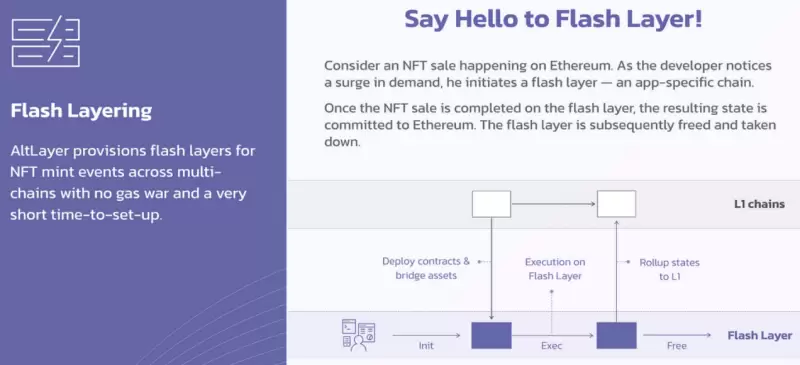
AltLayer proposes an elastic scaling solution to better meet the short-term peak Mint demand of NFT projects and alleviate long-term burdens. AltLayer can flexibly configure resources according to dApp requirements, solving the experience impact caused by resource competition in a single-layer network.
Specific implementation:
• Quickly launch a Layer1-secured Rollup solution during dApp peak;
• Eliminate Layer1 congestion risk using Rollup;
• Return to Layer1 for settlement and clearing after the Rollup task ends.
This model customizes an independent Mint layer for each NFT project. In addition to eliminating congestion, it provides an exclusive high-throughput, low-latency environment, greatly enhancing user experience. Overall, it optimizes resource allocation, covering NFT short-term peaks, balancing efficiency and cost, and truly achieving demand-driven upgrades.
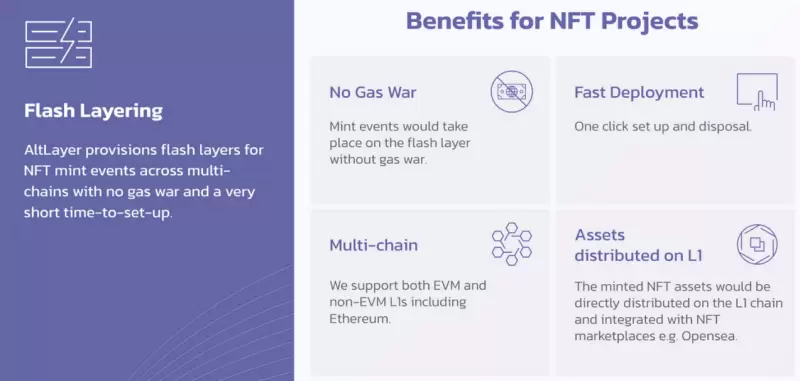
AltLayer provides the following advantages:
• Automatic Settlement – After the NFT minting is completed, the system automatically settles all assets from the Rollup layer to the underlying chain, without user intervention, reducing security risks.
• Multi-chain Compatibility – Default support for EVM and WASM standards, compatible with a wider range of projects.
• Complete Liquidity – After the minting is completed, all NFTs automatically drop to the underlying chain, ensuring that participants in the secondary market can find the desired NFT without cross-chain transactions.
• Avoid Congestion – Each NFT project has its exclusive execution layer, completely isolated from other activities, and cannot affect each other, ensuring productivity.
With automatic settlement, multi-chain support, liquidity guarantee, and exclusive resources, AltLayer solution helps NFT projects efficiently complete minting, while taking into account user experience and system efficiency, truly achieving demand-driven upgrades.
2) Gamefi
Running blockchain games faces certain challenges, including:
• Insufficient performance of general public chains, making it difficult to meet the scale and requirements of games.
• Games require customization and adjustment of chain rules to optimize the experience.
• The tokens on which games rely need independent control over their ecosystems.
In response to this, AltLayer’s Flash Layer solution is excellent:
• It sets up on-chain space specifically for different games, isolating other interferences and ensuring high performance.
• Game developers can customize rules according to their needs, focusing on the gaming experience.
• After the game ends, assets automatically roll back to the underlying chain, saving development costs.
It is suitable for two types of common games:
• Short-term event-based games, such as “Murder Game”. The Flash Layer can be started and ended immediately after the event.
• Independent studios developing standalone games with short lifecycles. The Flash Layer also starts and ends periodically according to the game’s lifecycle.
In summary, the Flash Layer protects games from on-chain disturbances, reduces costs, truly focuses on the experience, and promotes the popularization of Web3 games.
3.5.3. Persistent Rollups
AltLayer provides persistent and secure rollups that are application-specific and compatible with EVM and WASM. Persistent rollups are particularly suitable for long-term applications, such as GameFi, SocialFi, MetaFi, and DeFi. Compared to transient Flash Layer, persistent rollups provide a customized execution environment for these long-running applications. It inherits the security of optimistic rollup while being able to parameterize customization for specific applications and support multiple virtual machines, making it particularly suitable for the aforementioned GameFi, SocialFi, MetaFi, and DeFi applications.
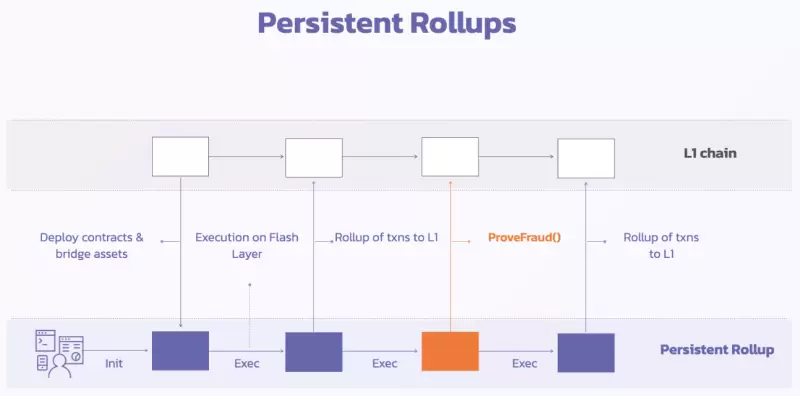
3.6. Ecosystem Collaboration
AltLayer is collaborating with external projects to improve user experience and data availability. The following are some introductions to the collaborations:
1) Using Biconomy for account abstraction
AltLayer uses Biconomy’s Meta-Transaction API to achieve account abstraction, allowing users to use AltLayer’s services without creating or managing Layer2 accounts. Users only need to use their wallet address and signature on Layer1 to transact on Layer2.
2) Using Celestia for data availability (DA)
Celestia is a modular consensus and data network that aims to provide a lightweight blockchain framework for anyone to deploy and manage their own blockchain. The core function of Celestia is to provide a data availability (DA) layer, which ensures the integrity and accessibility of Layer1 data. AltLayer can leverage Celestia’s DA layer to implement data availability sampling (DAS), allowing Layer2 validators to verify the correctness of Layer2 transactions without downloading or storing all Layer1 data. This way, AltLayer can greatly improve the scalability and efficiency of Layer2 while ensuring the security of Layer1.
3) Achieving permissionless interoperability with Hyperlane
Hyperlane is a cross-chain protocol based on Optimistic Rollup, enabling fast and cost-effective asset transfers between any Layer2 chains. It uses a cross-chain protocol based on state channels and zero-knowledge proofs to enable atomic swaps and generic calls between different blockchain networks. AltLayer uses Hyperlane’s cross-chain bridge to achieve permissionless interoperability with other Layer2 solutions. By utilizing Hyperlane, AltLayer can expand its ecosystem and user base.
3.7. Project Data
According to data released on AltLayer’s official Twitter account, as part of the Altitude Phase 3, over 100,000 Flash Layers have been deployed. However, since the Testnet and Mainnet have not been officially launched yet, there are currently no publicly available project-related data such as user count, transaction volume, and revenue. Nevertheless, we can anticipate significant market demand and potential for AltLayer upon its launch.
4. Industry Space and Potential
4.1. Industry Overview
4.1.1. Project Classification
AltLayer can be classified as a blockchain scalability solution and Web3 infrastructure, specifically categorized as an RaaS protocol.
• Blockchain Scalability Solution: AltLayer is a blockchain scalability solution based on Rollup technology, enabling off-chain transaction execution with on-chain result verification to improve blockchain throughput and efficiency.
• Web3 Infrastructure: AltLayer is a Web3 infrastructure that provides an efficient, flexible, and secure scalability solution for Web3 applications while reducing development and operational costs and complexity.
• RaaS Protocol: AltLayer is a decentralized and resilient RaaS (Layer2 as a Service) protocol that allows application developers to quickly deploy and customize their own execution layer (also known as Layer2).
4.1.2. Track Size
According to the market report on blockchain technology, the global blockchain technology market is expected to grow from $3.49 billion in 2020 to $39.46 billion in 2028, with a compound annual growth rate of 48.4%. Scalability is one of the biggest challenges faced by blockchain technology, and it is also one of the biggest driving forces behind market growth. As more and more applications enter the blockchain field, the demand for efficient, low-cost, and user-friendly scalability solutions will continue to increase. AltLayer, as a Rollup-as-a-Service (RaaS) protocol and Web3 infrastructure based on Rollup technology, has tremendous market potential and competitive advantages.
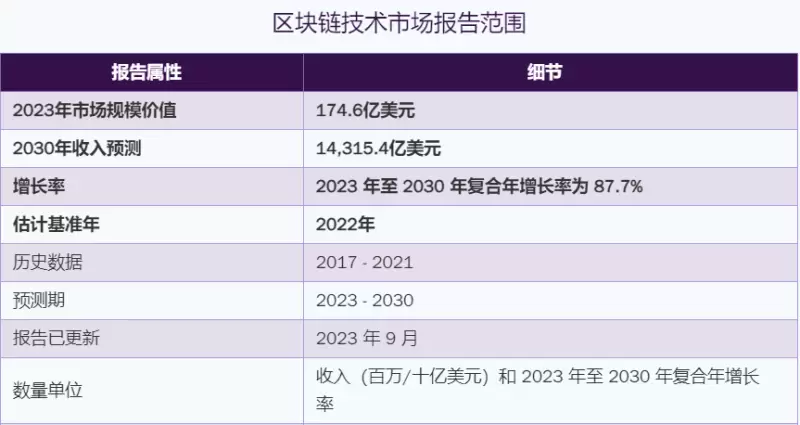
4.1.3. Core Competitive Factors
Rollup-as-a-Service (RaaS) is mainly used to improve the transaction processing capabilities of Ethereum and other public chain networks. The core competitive factors among competing products of RaaS protocols mainly include technical strength, product usability, supported features, ecological cooperation capabilities, decentralization level, and performance level.
Technical Strength: The technical team behind the RaaS platform directly determines the quality of its products and services. Teams with high technical proficiency are more likely to develop solutions that are more efficient and stable.
Product Usability: The convenience and usability of the Rollup deployment tools and services provided by RaaS platforms are also important. A good user experience can increase developer stickiness.
Supported Features: The comprehensiveness of supported chain types, virtual machine types, and functional modules is also a competitive factor. The more features supported, the wider the range of applications.
Ecological Cooperation Capabilities: Different RaaS protocols may cooperate with different public chain platforms, data service providers, developer communities, etc., to build the entire Rollup ecosystem. Ecological cooperation capabilities determine the market size and influence of RaaS protocols, as well as customer trust and loyalty.
Decentralization Level: Different RaaS protocols need to ensure the decentralization level of their components such as sorters, validators, and settlement layers to prevent centralization failures or attack risks. The higher the level of decentralized consensus mechanisms and transaction sorting, the better the reliability and security.
Performance Level: Different RaaS protocols need to guarantee the performance indicators such as throughput and latency of their Rollups to meet increasingly complex business needs. Performance level directly affects user experience, and superior performance is more favored.
In addition, network effects, project resource support, and token model design are also influencing factors.
4.2. Track Analysis
The Rollups-as-a-Service (RaaS) project aims to innovate the deployment of Rollups by providing easy-to-use Rollup development tools and service SDKs to abstract technical difficulties, design no-code and low-code Rollup construction interfaces, and share sorters. This lowers the user threshold, ensures efficient and seamless transaction processing, and provides one-click Rollup deployment solutions.
Simply put, RaaS is similar to Software as a Service (SaaS). Developers do not need to build the underlying infrastructure themselves. Instead, they can create and manage Rollups through RaaS services, which greatly reduces the threshold for developing and maintaining Rollups. This is similar to the emergence of Amazon Web Services (AWS), which allows enterprises to obtain elastic, convenient, and efficient computing power directly through cloud services without building their own services and storage infrastructure. Similarly, RaaS provides elastic and scalable Rollup execution layers, allowing on-chain applications to achieve higher transaction throughput and lower usage costs when necessary. This brings significant competitive advantages to blockchain applications.
The current competition for AltLayer mainly includes competition between application chain building infrastructure and competition among segmented products within the RaaS track.
4.2.1. Competition between application chain building infrastructure
More and more dapps choose to build their own application chains to achieve greater customization and control, in order to solve the performance and scalability issues of public chains. Currently, application chains are mainly built on Cosmos SDK, Polkadot, and Avalanche, each with its own strengths and weaknesses. AltLayer, as a cross-chain Optimistic Rollup solution, provides temporary elastic scaling capabilities. When the application chain encounters a short-term surge in demand, AltLayer can be used to quickly obtain scaling support without permanently building an application chain. AltLayer allows the application chain to migrate its state back to the application chain after scaling, achieving composability with the public chain. AltLayer can be seen as a complementary solution to the application chain, helping it cope with short-term peaks, and the two can coexist and cooperate. At the same time, AltLayer itself can also support the construction of application-specific Persistent Rollups, forming partial competition with the application chain.
Overall, AltLayer provides a new type of scaling and resource optimization solution for application chains through its flexibility and interoperability. Although they have different positioning, there is also competition and cooperation between them.
4.2.2. RaaS track landscape
Currently, RaaS projects in the market can be mainly divided into three categories: SDK, no-code solutions, and shared sequencers.
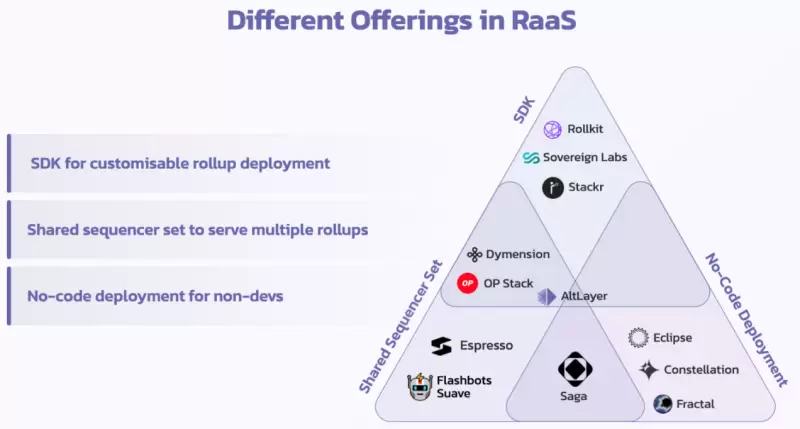
1) SDK
SDK solutions provide developers with a complete set of general software development kits, making it as easy to deploy Rollups as deploying smart contracts. There are already multiple SDKs in the market to meet different needs and scenarios. Here are some representative SDK projects:
•Rollkit by Celestia – Using Cosmos SDK and communicating through IBC, it provides a solution for deploying sovereign Rollups. Developers have complete control over execution and settlement and use Celestia as the data availability layer.
•OP Stack – Using OP Rollup technology, it organizes the network into three different layers: consensus layer, execution layer, and settlement layer. To simplify development, these three layers are standardized through APIs, allowing developers to easily fork and assemble components to meet their specific needs.
• Dymension’s RollApp Kit – Provides compatibility with various virtual machines, allowing developers to choose from different smart contract platforms such as CosmWasm or Ethermint, or any other platform supported by the Cosmos ecosystem.
• Sovereign SDK – Designed to simplify the creation of zk-Rollup, similar to how the Cosmos SDK simplified the creation of App-chains. It will be the first Rollup framework that eliminates zero-knowledge complexity, enabling developers to easily build applications without advanced cryptographic skills.
The availability of these SDKs means that the RaaS market is maturing, and there is an increasing demand for user-friendly Rollup deployment solutions. Each SDK offers unique advantages, and developers can choose the most suitable SDK based on their needs and requirements.
2) No-code solutions
No-code Rollup deployment solutions aim to make it easier for developers to create and manage Rollups. The current no-code deployment products mainly include:
• Constellation – Based on OP Stack, it allows developers to easily customize EVM-compatible Optimistic Rollup, with features such as block explorer and asset bridging. It can be customized through options such as block time and account permissions.
• AltLayer – A Rollup-as-a-Service platform that supports multiple chains and virtual machines, serving as a general-purpose scaling solution for various chains. Each Rollup is customized for a specific application, and the platform is designed to work with multiple blockchains and virtual machines. It supports Ethereum (EVM) and WebAssembly (WASM) for versatility. AltLayer is a flexible scaling solution for all compatible chains, not limited to a single layer1 or layer2.
• Eclipse – Built on the Cosmos SDK, it provides developers with a customizable Rollup framework for building Rollups tailored to different chains. As the infrastructure for modular blockchains, it can provide a universal settlement layer solution for any public chain. It aims to be a general-purpose Layer2 platform compatible with multiple Layer1 blockchains. Currently, Eclipse supports Ethereum Virtual Machine (EVM) and Solana Virtual Machine.
• Caldera – A customizable Rollup framework built on op-rollup, which focuses on building high-performance, customizable, and application-specific Layer1 blockchains. These customized blockchains offer high throughput, low latency, and customizable features to optimize the performance and user experience of decentralized applications. Caldera Chains can choose any EVM-compatible chain.
These products provide developers with graphical interfaces and configuration options, allowing them to deploy Rollups suitable for their projects in minutes without programming. They realize the transformation of Rollup technology towards no-code deployment, significantly reducing the development threshold.
Compared to traditional hand-written code, these no-code Rollup solutions make it easier for developers to independently manage scaling needs. They have the ability to fine-tune parameters for specific applications or scenarios. With the development of the industry, it is expected that more comprehensive and user-friendly no-code Rollup deployment solutions will emerge.
3) Shared Sequencer
The transaction sequencer is the core component of Layer 2 architecture. It collects transactions off-chain, generates blocks, and submits data to the main chain. The solution of the shared sequencer is to share the decentralized sequencer service with multiple Rollup networks. The Rollup sequencer is responsible for grouping and compressing transactions, and then submitting them to the main chain. This decentralized design enhances the network’s resistance to censorship, ensures efficient and seamless transaction processing, and achieves secure and stable operation of the Rollup system.
Currently, most Rollup solutions on Ethereum use centralized sequencers. However, some RaaS projects are developing decentralized shared sequencers, including:
• Optimism Collective – provides shared sequencer nodes for the OP Stack chain, which are centrally managed by Optimism.
• Dymension – based on Cosmos, it is a modular blockchain project that aims to simplify the deployment of RollApps through Dymension Chain (settlement layer), RDK (RollApp development toolkit), and IRC (Rollup intercommunication). Sequencer nodes need to stake DYM tokens in their settlement layer and are generated through elections.
• Espresso – can provide sorting services for different Rollups. Espresso Sequencer is designed as a platform that can deploy any zk-VM or optimistic VM. In the future, it can serve as a cross-chain interoperability layer, supporting multiple virtual machines.
The advantage of decentralized shared sequencers is that they can serve multiple Rollups, improving resource utilization. They are also more reliable, avoiding single points of failure. Additionally, mechanisms such as staking and PoS ensure the reliability of the nodes.
In general, shared sequencers are a key infrastructure for achieving multi-chain interoperability and cross-chain communication. With the maturity of technology, it is expected that decentralized shared sequencers will gradually replace centralized sequencers and provide strong support for the development of Rollups and Layer 2.
4.2.3. Overall Pros and Cons of RaaS
In the future, the multi-chain and multi-Rollup trend is prominent in the cryptocurrency industry. As more projects emerge, they will also look for public chains that offer higher performance, lower costs, and even customized services. The development of RaaS lays the foundation for this.
1) From the overall perspective of RaaS, it currently has the following advantages:
• Provides greater control and customization: RaaS allows developers to highly customize their own Rollups according to specific business needs, rather than just using generic solutions, to meet the specific requirements of their projects.
• Avoids the risk of significant fluctuations in transaction fees: RaaS can minimize the sudden increase in gas fees caused by network congestion, allowing developers to avoid the risk of skyrocketing fees.
• Achieves low latency and high throughput: RaaS can provide higher transaction throughput and lower network latency, which is especially important for applications that require high-frequency trading.
• Empowers developers to realize their own technical vision: RaaS allows developers to achieve their visions for product functionality and user experience even within existing constraints.
• Internalize MEV and transaction fees: Developers can obtain economic benefits such as MEV and transaction fees through RaaS.
• Add more practical use cases for tokens: RaaS can be used to design more use cases for project tokens, increasing their value.
• Meet the increasing demand for scalability solutions for on-chain applications: With the application of more dapps, the demand for RaaS solutions will continue to grow.
2) From the overall perspective of the RaaS track, its disadvantages mainly include the following aspects:
• Technical risks: Rollup technology itself is still in development, with uncertainties. Core technologies such as fraud proofs and security need commercial validation, and technical challenges such as multi-chain interoperability and performance improvement need continuous exploration;
• Business risks: The business feasibility of the RaaS model needs to be validated in practice, and the user scale and commercialization path are uncertain. The pricing strategy for track products also needs continuous optimization in competition;
• System risks: There is a certain degree of centralization tendency, and reliability needs to be considered. There are security vulnerability risks in bridge design and other aspects. At the same time, fluctuations in the crypto economy may also affect ecosystem development, and potential regulatory risks need to be considered;
• Comprehensive risks: The project is still in the early stage of development, and various elements are not fully mature. Continuous iteration and progress are needed in technology, products, and business. At the same time, the dynamic changes of competitors require maintenance of market position, and there are uncertainties in terms of funding and talent;
In general, AltLayer, as an innovative RaaS platform, faces challenges and risks at various levels from technology to business. It needs to maximize opportunities while addressing risks in order to achieve evolution from concept to commercialization and then to infrastructure.
4.2.4. AltLayer Competitive Advantages
• AltLayer is the only RaaS platform that provides temporary Rollup services. Its Flash Layer allows developers to quickly create disposable Rollups to deal with short-term traffic peaks. This avoids wasting resources for temporary needs by building the entire chain.
• AltLayer has built a decentralized Beacon layer as a shared sequencer network, making it one of the few RaaS platforms with decentralized sequencers. Decentralized sequencers enhance the security and reliability of Rollups.
• AltLayer has implemented anti-fraud mechanisms such as binary fraud proofs and has been successfully running on multiple public chains. This ensures the secure execution of AltLayer Rollups and makes it one of the few RaaS platforms capable of running fraud proofs.
• AltLayer has been committed to supporting a multi-chain environment from the beginning, and it supports mainstream virtual machines such as EVM and WASM. This allows developers to flexibly deploy AltLayer Rollups in different networks, and its multi-chain and multi-virtual machine support capabilities are industry-leading.
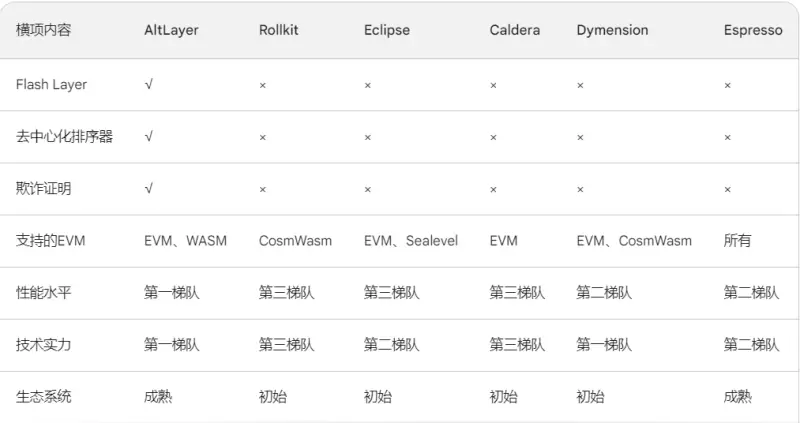
The above content is mainly sorted based on core competitive factors, which may be subjective. Readers can evaluate it themselves. From the above, it can be seen that compared with other RaaS competitors, AltLayer has unique advantages and leading technology in Flash Rollup, decentralized sorting, anti-fraud proof, and multi-chain support, making it a fully functional and technologically advanced RaaS provider.
4.3. Token Economics Analysis
4.3.1. Token Supply and Distribution
AltLayer has not released token information yet.
4.3.2. Token Value Capture
Possible value capture of AltLayer token:
1) Platform Service Usage Fee
As an RaaS platform, AltLayer can charge a certain service fee based on the number of times users use the Launcher to start Rollup. This fee will become a continuous source of platform revenue. As the number of users and application scenarios grow, the value capture space will continue to expand.
2) Staking and Rewards of Coordinating Nodes
On AltLayer’s Beacon chain, running sorting nodes requires staking native tokens. At the same time, honest sorting nodes can obtain rewards through block production and charging fees. This will incentivize more nodes to join the consensus and generate continuous token demand.
3) Governance Rights
Holders of native tokens will have the voting rights for platform governance. They can participate in the formulation of important decisions regarding platform development direction, economic parameters, new features, etc. This gives the token normative governance value.
4) Additional Application Scenarios
ALT tokens can also be designed to be combined with more application scenarios, such as running nodes, accessing data, paying fees, etc., continuously enhancing the role of tokens in the ecosystem. This provides further possibilities for the expansion of ALT.
In summary, ALT tokens capture value through platform service fees, consensus mechanisms, governance rights, and additional applications, closely linking them to the growth of the AltLayer platform and possessing a good mechanism for sustainable empowerment.
4.3.3. Core Token Demand Parties
1) AltLayer Platform Users
AltLayer’s no-code Rollup launcher will have developers, enterprises, and individual users. They need to use ALT tokens to pay for platform usage fees. As the user base and application scenarios grow, this demand will continue to rise.
2) Rollup Node Operators
To run consensus nodes on AltLayer’s Beacon chain, ALT tokens are required for staking. At the same time, nodes can also obtain rewards through block production. This will drive the demand for holding and circulating ALT tokens.
3) Ecological Cooperation Partners
Collaboration with other projects can bring more scenarios and enhance the demand for ALT tokens. This will also attract more users and funds to enter the ecosystem.
4) Potential Users
As the platform’s influence increases, more potential users will join, driving the demand for services and node fees.
5. Preliminary Valuation
As an emerging RaaS service platform, AltLayer has a broad market space and is currently undervalued. It is expected to achieve multiple growth in the rapid development of the industry.
5.1. Core Issues
Which stage of the business cycle is the project in? Is it in the mature stage or in the early to middle stage of development?
AltLayer, as an innovative RaaS solution provider, is currently in the early stage of development.
1) The product features are still under rapid iteration, mainly adopting the form of Minimum Viable Product (MVP) to obtain user feedback and iterate the product quickly. 2) The technical framework is also continuously optimized and improved, with some core components such as consensus mechanisms and cross-chain support needing further enhancement. 3) The user base is still relatively small, mainly early adopters and technology enthusiasts. 4) It needs to further expand the user base, especially the adoption by application developers. The business model needs further validation, including determining pricing strategies and profit models. 5) The token economic model design is still being improved and needs to be combined with user incentive mechanisms. 6) The project has limited influence and needs to build its brand through community construction and content marketing. 7) The organization is still more reliant on the founding team and needs to gradually achieve decentralization of power and community autonomy. In summary, AltLayer is in the early stage of rapid growth, still some distance away from maturity, but it is in a high-growth track with great future potential.
Does the project have reliable competitive advantages? Where do these competitive advantages come from?
AltLayer has the following reliable competitive advantages:
- Early entry into the RaaS field: AltLayer can be considered one of the projects that explored the RaaS model early, giving it a certain first-mover advantage in this track.
- Strong technical strength: AltLayer is built by blockchain technology experts, and the team has accumulated rich experience in underlying blockchain technology, capable of developing future-oriented technologies.
- User-friendly design: AltLayer has greatly improved product usability from codeless deployment to user interface optimization. This helps to acquire users faster and establish a leading position.
- Technological innovation capability: AltLayer has conducted technological innovation in consensus mechanisms, fraud proofs, etc., maintaining a technological leadership position.
What are the main variable factors in the project’s operations? Are these factors easy to quantify and measure?
- Growth of user base: The number and activity of users are key variables in project operations. The growth trend can be quantified and measured through registered user data, active user data, transaction data, etc. User growth is an important indicator of achieving network effects in the project.
- Number of supported public chains: The number of public chains supported by AltLayer reflects the breadth of the project’s applicable scenarios. This variable can be quantified directly by counting the number of public chains. Its growth will enhance the versatility of AltLayer.
- Transaction volume: The number of transactions processed by AltLayer’s Rollup reflects resource utilization and service scale. Transaction volume data can be directly obtained from on-chain data. The transaction volume is also related to operational revenue.
- Number of developers: The number of developers represents the recognition of the product by developers. This variable can be obtained through the number of registered developer accounts. An increase in the number of developers indicates an increase in platform influence.
All the above indicators can be quantified and measured, and they are key variables for evaluating the operational performance of AltLayer. Their changes are directly related to the growth of the project.
What is the project’s management and governance approach?
Currently, AltLayer is responsible for product development and daily management by the founding team, and the core team has decision-making power over the project’s strategic planning and technical roadmap. As the project develops, AltLayer plans to gradually decentralize power and achieve community autonomy. In the future, AltLayer will transition to a DAO governance structure, allowing token holders to participate in discussions and voting mechanisms to collectively determine the platform’s development direction.
5.2. SWOT Analysis
5.2.1. Project Strengths
For detailed project strengths, please refer to section 1.1 Core Investment Logic
• Excellent technical development team
• Two major technological innovations in product design: codeless deployment and decentralized coordination
• Clear market positioning and demand
• Advanced technical framework design and highly user-friendly services and products
5.2.2. Project Weaknesses
• The project is still in its early stages: AltLayer’s related products are in the development and trial operation stage, and further technological accumulation and market cultivation are needed before large-scale commercial use. The project is in a phase of rapid iteration and requires time to grow and accumulate.
• Limited user base and influence: As a new project, AltLayer’s user base is still in the early stages of formation. Its brand influence and industry recognition are limited, and it needs to expand its user base through product optimization and marketing promotion.
• Numerous competitors: There are many participants in the RaaS market, and other excellent teams are also developing similar products. AltLayer needs to continuously optimize its product performance, user experience, and other aspects to maintain competitiveness.
• Limited funds and resources: As a new project, AltLayer’s allocation of funds and resources is relatively low. This will have a certain impact on the research and development process. Continuous financing is required to expand resources.
In addition, AltLayer’s token economic model has not been announced and needs to be verified. At the same time, there are technical challenges to overcome in areas such as multi-chain interoperability, fraud-proofing, and off-chain performance. These are all existing risks.
5.2.3. Project Opportunities
• Strong and continuous growth in public chain scalability demand: The transaction volume of public chains such as Ethereum is rapidly increasing, creating a huge and continuous demand for scalability solutions. This provides ample market space for Rollup-like solutions.
• Prosperous development of Rollup and other L2 technologies: Rollup technology is rapidly developing and popularizing, and more and more projects are adopting Rollup. This brings broad demand space for RaaS platforms like AltLayer.
• Rapid growth stage of the crypto economy: With more and more capital and users entering the space, the crypto economy is experiencing rapid growth. New application scenarios continue to emerge, and various types of dApps are rapidly emerging, all of which require highly scalable solutions, which will promote the development of RaaS services. This provides a huge opportunity for RaaS infrastructure.
• User base rapidly expands, increasing industry collaboration opportunities: The number of Crypto users is growing rapidly, which will bring a broader user base to AltLayer and make network effects easier to occur. At the same time, as the industry develops, there will be more collaboration opportunities between different infrastructure projects, which will also bring new cooperation and application scenarios to AltLayer.
5.2.4. Project Threats
The main threats to AltLayer’s project are the challenges currently existing in the RaaS track (see section 4.2.3 for details). In addition, AltLayer also faces some unique threats:
Competition and being left behind by rapid technological development: In the rapidly developing field of blockchain technology, AltLayer faces the risk of being surpassed by competitors. As the prospects of the RaaS market are proven, more competitors will be attracted to this track, and these newcomers will bring direct competitive pressure to AltLayer. If AltLayer’s technological innovation speed does not keep up with the industry’s forefront, its products and services may be surpassed by competitors. Moreover, blockchain technology iterates and updates at an astonishing speed daily. If AltLayer cannot sustain large-scale investment in talent, funds, etc., its technological accumulation will struggle to keep up with the progress of blockchain technology. This will also lead to competitors catching up with and even surpassing AltLayer’s technological advantages.
Security and technical vulnerability threats and business model verification threats: AltLayer’s RaaS protocol involves multiple technical aspects and business scenarios, which may encounter technical challenges and security risks. If security and technical vulnerabilities occur, it may result in user asset losses or being exploited by hackers. The RaaS protocol also needs to undergo sufficient testing and verification to demonstrate its feasibility and reliability. At the same time, if AltLayer cannot rapidly expand its user base and its growth rate slows down, its business model cannot be verified, and token demand will be affected. Facing various competitors, AltLayer needs to continuously expand application scenarios and attract users.
6. References
https://www.altlayer.io/ AltLayer official website
https://twitter.com/Alt_Layer AltLayer official Twitter
https://blog.altlayer.io/ AltLayer official Medium
https://forkast.news/rollups-as-a-service-raas-web3/ AltLayer related reports
https://t.me/s/altlayer AltLayer Telegram
https://docs.altlayer.io/altlayer-documentation/welcome/overview AltLayer DOC documentation
https://www.panewslab.com/zh/articledetails/vuvlnozu.html Rollup as a Service: A new situation in blockchain scalability, the next modular battlefield
Like what you're reading? Subscribe to our top stories.
We will continue to update Gambling Chain; if you have any questions or suggestions, please contact us!